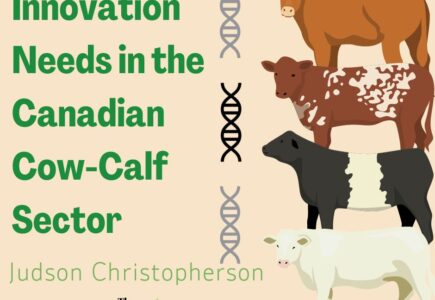The Sustainability Narrative Surrounding Beef
Currently, beef production is viewed as unsustainable by many ill-informed journalists, activists, and policymakers. In fairness, beef production produces high GHG-emissions per unit of energy output relative to other farming operations. However, what is rarely considered in sustainability discussions surrounding the beef industry are the ecosystem services provided by livestock production. The cattle production sector is rapidly evolving to improve on many sustainability metrics such as improving carbon sequestration and lessening the GHG emissions produced per pound of beef. Simply put, the industry is striving to produce a greater volume of beef per unit of emissions. The path forward is neither clear nor smooth however, this blog details some arising opportunities that could transform the cow-calf sector.
Innovation in Genetic Modification
The rise of new genetic modification technologies, such as CRISPR, have opened the gate to the genetic modification of animals, including cattle. As with any genetic modification technology, the ability to select desirable traits and weave them into the genetics of breeding herds provides significant opportunity for improvements in both economic and environmental sustainability. First, genetic traits responsible for the rapid and efficient growth of cattle could be widely spread in a narrow timespan. Improving muscle building capacity, feed conversion rates, and disease resistance in breeding and feeder livestock would greatly enhance industry efficiency. By incorporating male traits into female animals, carcass weights would expand and rates of growth would hasten. This, alongside improvements to feed conversion ratios, would lessen the requirement of inputs such as forage, grains, and water to dampen the environmental impact while producing more beef. Similarly, improving feed conversion ratios would mean fewer inputs would be required per pound of gain. Genetically modifying animals for disease resistance would bolster efficiency gains by limiting death loss, an alteration that could bring up to 15% more cattle to market if the entire production cycle is considered. Additionally, serious threats to livestock and human health such as bovine tuberculosis could be better managed with gene editing. In combination, improvements in these three metrics would drastically change the beef industry, resulting in far greater production per unit of GHG emissions.
Genetically modified crops could similarly serve the beef industry’s pursuit of environmental and economic sustainability. Genetic alterations to improve nutritive value would achieve and build upon many of the gains expected from genetically modified animals. An additional benefit would come from improved forage quality in the context of enteric emissions: the higher the quality of the forage fed to animals, the lower enteric methane emissions will be. Likewise, modifying feed source forage crops to be pest resistant would result in greater forage quality, volume, and resilience to lessen the need for fertilizers, chemicals, and the reseeding of perennial forages. Finally, increasing the availability of herbicide tolerant forage crops and forage blends would improve the quality and yield of pastures and feed alike, lessening the emissions and resource requirements of each pound of beef. Therefore, heightening the quality of forages could substantively reduce total methane emissions from the industry.
Overcoming Regulatory Barriers
Rightfully so, regulatory bodies around the world are concerned with the safety of the nourishment we place in our bodies as humans. However, gene editing technology has been shown to be safe throughout decades of use in the Canadian food system. Nonetheless, bureaucracy and activist opposition may slow the advent of beneficial and potentially industry-changing technologies. Comparably, technologies currently available that should receive fast-track approvals are those such as 3-NOP. 3-NOP is a feed supplement that has been shown to significantly reduce enteric methane emissions in beef cattle. Despite its ability to reduce enteric methane emissions by up to 30%, the path to regulatory approval will be lengthy and producer adoption may not be as a rapid as hoped . Nonetheless, optimism surrounding the future of the beef industry should be heightened as new and exciting innovations are on the horizon. Furthermore, if record cattle prices hold the industry may become more attractive for long overdue research and development, generating a period of growth in the sustainability of the Canadian cattle sector for an environmental and economic standpoint.


